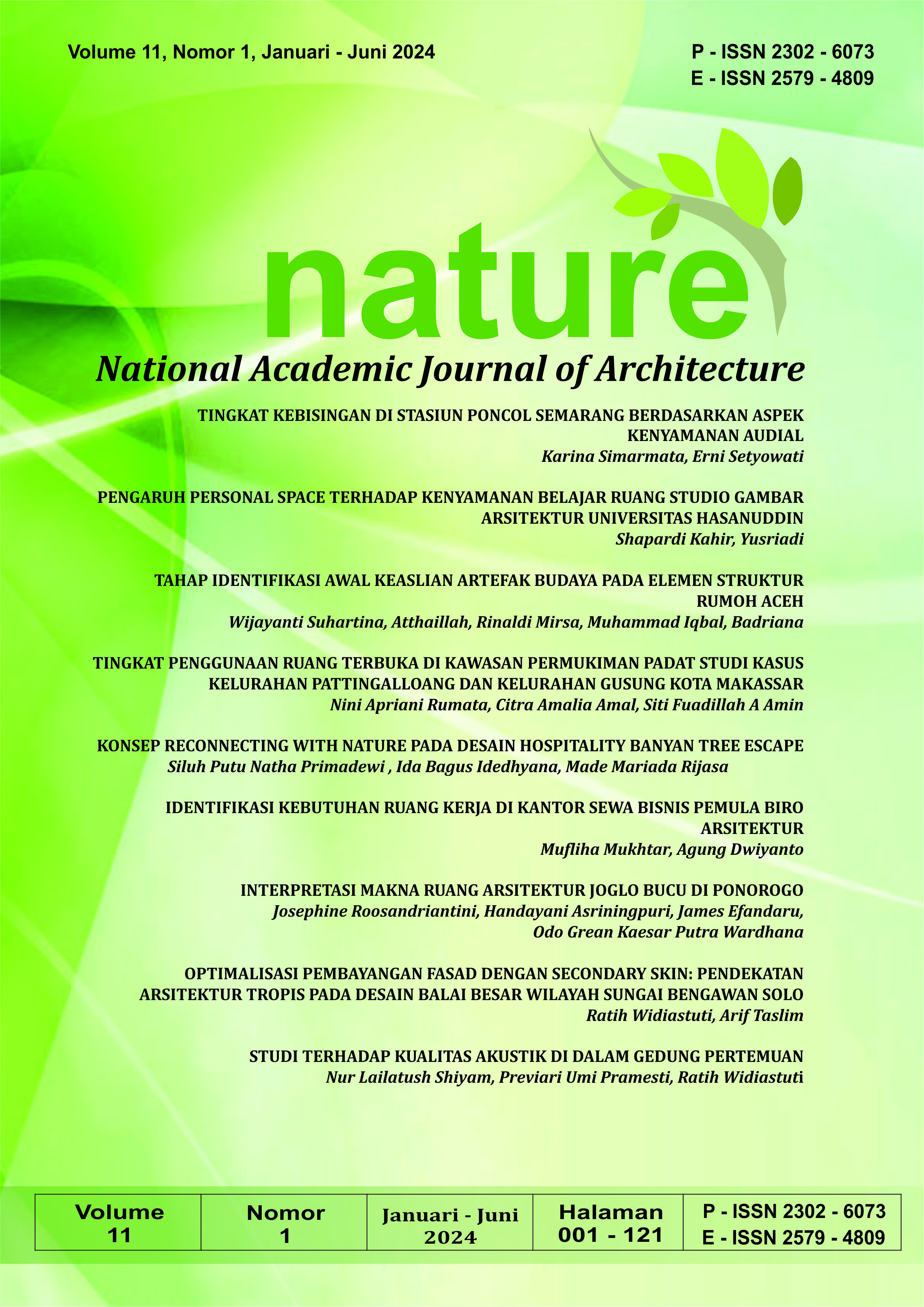Pengaruh Personal Space Terhadap Kenyamanan Belajar Ruang Studio Gambar Arsitektur Universitas Hasanuddin
Abstract
The drawing studio is a space where students complete core architectural design courses in the architecture department. The studio is a space for carrying out various activities such as discussions with fellow participants and lecturers, making programs and plans, conducting precedent studies, presenting images, looking for ideas, and making designs. This research aims to identify students' personal space in the drawing studio room of the architecture department at Hasanuddin University and its influence on study concentration. This research uses a qualitative descriptive method. A purposive sampling strategy was used to collect data through questionnaires and interviews. Descriptive analysis method to analyze data regarding students' personal space in learning. There were 64 people in the research sample, namely 30 people from the 2019 class and 34 people from the 2018 class. The research results show that students' personal space is divided into 4 distance groups: intimate distance, personal distance, social distance, and public distance. Situational factors, individual activities, personality, gender, and age are things that influence personal space. Personal space has an influence on concentration in studying in the drawing studio room. The close proxemic distance makes it more difficult for students to carry out activities so concentration decreases, while the longer proxemic distance makes students more free to carry out activities and can concentrate better. Distance between individuals is one of the variables that influences learning comfort.
Downloads
References
Altman, I. and Vinsel, A.M. (1977) ‘Personal Space: an Analysis Of ET Hall’s Proxemics Framework’, in Human Behavior and Environment: Advances in Theory and Research Volume 2. Springer, pp. 181–259.
Anita Mutiarabia and Mutia, F. (2022) ‘Dampak kualitas ruang pada personal space pengguna di Dinas Perpustakaan dan Kearsipan Provinsi Jawa Timur’, Berkala Ilmu Perpustakaan dan Informasi, 18(1), pp. 86–97. Available at: https://doi.org/10.22146/bip.v18i1.2007.
Bell, P.A. et al. (2001) Environmental psychology. New Jersey.
Bowers, B.S. and Manzi, T. (2006) ‘Private Security And Public Space: New Approaches to the Theory And Practice Of Gated Communities’, European Journal of Spatial Development, 4(4), pp. 1–17.
Brown, N. (2001) ‘Edward T. Hall: Proxemic Theory, 1966’, Center for Spatially Integrated Social Science. University of California, Santa Barbara. http://www. csiss. org/classics/content/13 Read, 18, p. 2007.
Casasanto, D. (2008) ‘Similarity and proximity: When does Close in Space Mean Close in Mind?’, Memory & Cognition, 36(6), pp. 1047–1056.
Dosey, M.A. and Meisels, M. (1969) ‘Personal space and self-protection.’, Journal of personality and social psychology, 11(2), p. 93.
Evans, G.W. and Wener, R.E. (2007) ‘Crowding and personal space invasion on the train: Please don’t make me sit in the middle’, Journal of Environmental Psychology, 27(1), pp. 90–94.
Graziano, M.S.A. and Cooke, D.F. (2006) ‘Parieto-frontal interactions, personal space, and defensive behavior’, Neuropsychologia, 44(13), pp. 2621–2635.
Hantono, D. (2019) ‘Kajian Perilaku Pada Ruang Terbuka Publik’, NALARs, 18(1), p. 45. Available at: https://doi.org/10.24853/nalars.18.1.45-56.
Kahir, S., Mulyadi, R. and Hamzah, B. (2023) ‘Room Gap Analysis of Thermal Comfort in Office Spaces: The Case of Office Space in The Barru Regent Tower Building, Indonesia’, International Society for the Study of Vernacular Settlements, 10(12), pp. 205–220. Available at: https://doi.org/10.61275/ISVSej-2023-10-12-14.
Kahir, S., Syam, S. and Harisah, A. (2020) ‘Persepsi Pengguna Terhadap Warna Interior Masjid’, Jurnal Lingkungan Binaan Indonesia, 9(1), pp. 20–30. Available at: https://doi.org/10.32315/jlbi.v9i1.97.
LaCroix, K. and LaCroix, S. (2017) ‘Does seat location matter? A review of the proximity effect in large and small classrooms’, Community College Enterprise, 23(2).
Lewis, L. et al. (2017) ‘What makes a space invader? Passenger perceptions of personal space invasion in aircraft travel’, Ergonomics, 60(11), pp. 1461–1470.
Naghiloo, F. and Falahat, M.S. (2016) ‘The effect of environmental factors on sociopetality of urban spaces’, European online journal of natural and social sciences, 5(4), p. pp-1111.
Namazian, A. and Mehdipour, A. (2013) ‘Psychological Demands of the Built Environment , Privacy , Personal Space and Territory in Architecture’, International Journal of Psychology and Behavioral Sciences, 3(4), pp. 109–113. Available at: https://doi.org/10.5923/j.ijpbs.20130304.04.
Pujadi, A. (2007) ‘Faktor-faktor yang mempengaruhi motivasi belajar mahasiswa: studi kasus pada fakultas ekonomi universitas bunda mulia’, Business Management Journal, 3(2).
Shin, J. et al. (2019) ‘Darling, get closer to me: Spatial Proximity Amplifies Interpersonal Liking’, Personality and Social Psychology Bulletin, 45(2), pp. 300–309.
Sugiono (2016) Metode Penelitian Kuantitatif, Kualitatif dan R&D.
Copyright (c) 2024 shapardi kahir

This work is licensed under a Creative Commons Attribution-ShareAlike 4.0 International License.
By submitting your manuscript to our journal, you are following Copyright and License











